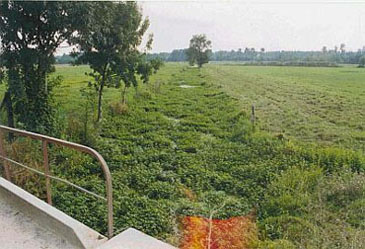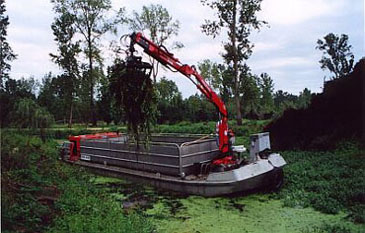- Presentations of the scientific workshop and open conference
- Abstract book: updated version (21.06.2006) (EN)
- Recommendations by the scientific community (EN/FR/NL)
- Black and watch list of invasive non-native species in Belgium
- Documents released for and by the press
> What are biological invasions?
More and more species are introduced deliberately or unintentionally outside their natural habitats due to the increasing rate of trade and travel in the world. Some of them have the ability to establish themselves in these new environments, beyond their natural barriers. Most of those recently established species will persist only through small and isolated populations, but a small fraction of them will adopt a more 'aggressive' behaviour. They will develop dense populations, spread all over landscapes, outcompete native species and disrupt ecosystem functionning.They are called 'invasive alien species' or IAS.
The water primrose Ludwigia peploides is a typical IAS. Originating from Latin America, it was introduced by accident in the South of France in the 1820s. It long remained in Camargue and Aquitaine, where it colonised a lot of water bodies. For roughly 30 years, it migrated towards the north and reached the Belgian border a few years ago. Monitoring and scientific studies show that the water primrose develops quickly and makes very thick seagrass beds responsible for biodiversity reduction, alteration of physico-chemical quality of water, wetland drying, disruption of irrigation infrastructure, etc. (see pictures).


Pictures : Nicolas Pipet (Institution Interdépartementale du bassin de la Sèvre Niortaise, France).
Invasive species can cause significant detrimental ecological and socio-economic impact. Their management costs - including prevention, population management and impacts on ecological services - are prohibitive. In a recent study David Pimentel et al. estimated that the cost per capita for the losses incurred due to biological invaders in the world is approximately 240$ per year and represents nearly 5% of the world economy. This enormous sum far exceeds the combined annual cost of all natural disasters, making the problem of biological invasions in both agricultural and natural ecosystems a high-priority issue!
But there is hope for counteracting the invasive species challenge, and much of that hope stems for new strategies being developped for preventing new introductions and adequately manage the populations of invasive species that are already installed. 'SOS invasions !' is an initiative which aims to gather scientific information on biological invasions in Belgium and will introduce the following points. How frequent are invasive species in our country? How can they be detected? How are they introduced? How do they spread in the environment? What is their impact on biodiversity and key economic sectors? Which new species are expected to invade our country in a close future? How to prevent and control biological invasions?
The first day of the conference will present a general overview of current scientific knowledge on invasive alien species in Belgium. The second day will focus on field experiences and analyse tools we have to our disposal to prevent and control biological invasions.





